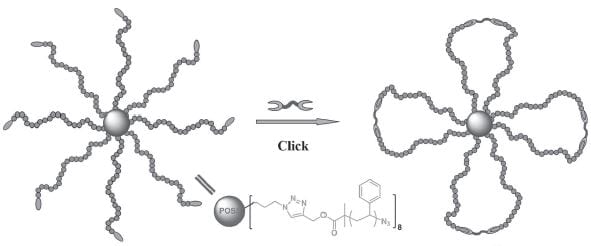 In their trend article, researchers from Hefei, China highlight general design concepts and chemical strategies using supramolecular assemblies for the synthesis of responsive polymers. Jinming Hu and Shiyong Liu present an overview of the topological structures that can be achieved with this method. Chemical reactions and the type supramolecular assemblies, which lead to these structures, are discussed.
In their trend article, researchers from Hefei, China highlight general design concepts and chemical strategies using supramolecular assemblies for the synthesis of responsive polymers. Jinming Hu and Shiyong Liu present an overview of the topological structures that can be achieved with this method. Chemical reactions and the type supramolecular assemblies, which lead to these structures, are discussed.
General polymerization strategies that are currently used, e.g., controlled radical polymerization and click chemistry, are not able to efficiently synthesize macrocycles or multiblock copolymers due to low efficiency and side reactions. In these cases, supramolecular assemblies can be used as templates during the polymerization and crosslinking to control the structure of the polymers. Additionally, supramolecular assemblies can also increase reactions yields and suppress side reactions by increasing local concentrations of reactants.
In the synthesis of linear polymers, supramolecular assemblies serve as template and segregation compartment. With these methods, defined, elaborated structures such as micellar nanoparticles or gels can be realized; and the molecular weight, monomer composition and sequence of the resulting polymers are well defined. In addition to synthetic structures, biological supramolecular assemblies, such as viral capsids or bacterial surfaces, can serve as templates and compartments.  To synthesize nonlinear polymers such as star copolymers, the right reactive groups have to be brought in close proximity, while others should not be made available. This is achieved by micellar structures, but there is a need for a larger variety of templates. Crosslinks in polymers are used to stabilize and fix microstructures. Current research focusses on the development of crosslinks, which are degradable at various conditions. Biocompatibility of crosslinked polymers could be achieved by nontoxic crosslinks and traceless crosslinking procedures. In general, there is a need for more sophisticated crosslinking chemistry to broaden the range of applications.
To synthesize nonlinear polymers such as star copolymers, the right reactive groups have to be brought in close proximity, while others should not be made available. This is achieved by micellar structures, but there is a need for a larger variety of templates. Crosslinks in polymers are used to stabilize and fix microstructures. Current research focusses on the development of crosslinks, which are degradable at various conditions. Biocompatibility of crosslinked polymers could be achieved by nontoxic crosslinks and traceless crosslinking procedures. In general, there is a need for more sophisticated crosslinking chemistry to broaden the range of applications.
The Best of Macromolecular Journals Edition 2016 is a special reprint issue highlighting the most impressive contributions from over one thousand articles published across the Macromolecular Journals family in 2015. All of these articles are free to access for one year. Find out more at www.best-of-macros.de.

















